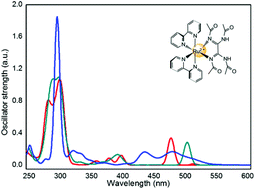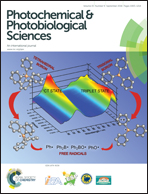A theoretical study of ruthenium complexes with 2,2′-biimidazole-like ligands: structural, optical and emissive properties†
Abstract
The structural and optical properties of five ruthenium complexes, recently synthesized for their photooxidative and photophysical properties, have been studied by means of density functional theory (DFT) and time-dependent DFT (TD-DFT). The structures of [Ru(bpy)2(BiimH2)]2+ (bpy = 2,2′-bipyridine; BiimH2 = 2,2′-biimidazole) 1, [Ru(bpy)2(TMBiimH2)]2+ (TM BiimH2 = 4,5,4′,5′-tetramethyl-2,2′-biimidazole) 5, [Ru(bpy)2(L1H2)]2+ (L1H2 = 4,5-dimethyl-2(N,N-diacetyl)(carboximidamide-1H-imidazole)) 6, [Ru(bpy)2(L2H2)]2+ (L2H2 = N1,N1,N2,N2-tetrakis(acetyl)ethanediimidamide) 7 and [Ru(phen)2(TMBiimH2)]2+ (phen = 1,10′-phenanthroline) 8 have been fully optimized in the electronic ground state as well as in the lowest triplet T1 excited state. The theoretical absorption spectra of the five complexes that compare rather well with the experimental spectra have been analyzed on the basis of TD-DFT calculations without and with spin–orbit coupling (SOC). The deprotonated form [Ru(bpy)2(L2H)]+7d contributes mostly to the experimental absorption spectrum of complex 7. The spectra of all molecules are characterized by the presence of low-lying metal-to-ligand charge transfer (MLCT) excited states between 500 and 400 nm, ligand-centered (LC) excited states on the biimidazole-like ligands between 350 and 300 nm and on the bpy ligands between 300 and 250 nm. The theoretical emission wavelengths deduced from the lowest triplet T1 properties calculated at 661 nm (1), 690 nm (5) and 660 nm (8) reproduce the experimental emission spectra of these molecules characterized by a maximum at 638 nm (1), 646 nm (5) and 652 nm (8). In contrast the low theoretical emission wavelengths (>1000 nm) obtained for complexes 6, 7 and 7d favorable to non-radiative decays explain the low intensity of the experimental emission spectra of these two complexes. The SOC is of little effect in this class of molecules where metal-centered (MC) excited states do not perturb the lowest part of the absorption spectra leading to negligible splitting of low-lying triplet states.


 Please wait while we load your content...
Please wait while we load your content...